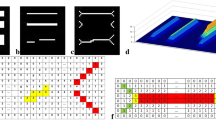Abstract
An unavoidable problem of most existing skeletonization algorithms for handwriting images is the production of undesired artifacts or pattern distortions. This paper presents a method of identifying these unreliable segments to improve the skeletons of handwriting images. In this method, a novel feature called iteration time is exploited, by which each unreliable segment can be treated as a set of points with exceptional iteration times. First, the iteration time of each skeleton point is calculated, and an undirected graph is built from the skeleton whose edges are weighted by defining a distance measurement between each pair of connected nodes based on iteration time. Then the set of unreliable segments is achieved by a graph clustering algorithm with an effective clustering quality function. Finally, the probability of two jointed reliable segments belonging to a continuous pair is estimated by a best-matched method, and a cubic B-spline interpolation is applied to reconstruct unreliable parts of the skeleton. Experimental results show that the proposed method can detect unreliable segments effectively and produce a skeleton that is closer to the original writing trajectory.









Similar content being viewed by others
References
Lam L, Lee S-W, Suen CY (1992) Thinning methodologies—a comprehensive survey. IEEE Trans Pattern Anal Mach Intell 14:869–885
Arica N, Yarman-Vural FT (2001) An overview of character recognition focused on off-line handwriting. IEEE Trans Syst Man Cybern 31:216–233
Lee S, Pan JC (1992) Offline tracing and representation of signatures. IEEE Trans Syst Man Cybern 22:755–771
Zhang TY, Suen CY (1984) A fast parallel algorithm for thinning digital patterns. Commun ACM 27:236–239
Han NH, La CW, Rhee PK (1997) An efficient fully parallel thinning algorithm. In: 4th International conference on document analysis and recognition, Ulm, Germany, pp 137–141
Huang L, Wan G, Liu C (2003) An improved parallel thinning algorithm. In: 7th International conference on document analysis and recognition, Edinburgh, Scotland, pp 780–783
Fan K-C, Wu W-H (2000) A run-length-coding-based approach to stroke extraction of Chinese characters. Pattern Recognit 33:1881–1895
Chouinard C, Plamondon R (1992) Thinning and segmenting handwritten characters by line following. Machine Vis Appl 5:185–197
Zou JJ, Yan H (2001) Skeletonization of ribbon-like shapes based on regularity and singularity analyses. IEEE Trans Syst Man Cybern 31:401–407
Zou JJ, Morrison P (2007) Triangle refinement in a constrained Delaunay triangulation skeleton. Pattern Recognit 40:2754–2765
Tang YY, You X (2003) Skeletonization of ribbon-like shapes based on a new wavelet function. IEEE Trans Pattern Anal Mach Intell 25:1118–1133
You X, Tang YY (2007) Wavelet-based approach to character skeleton. IEEE Trans Image Process 16:1220–1231
Liao CW, Huang JS (1990) Stroke segmentation by Bernstein–Bezier curve fitting. Pattern Recognit 23:475–484
Liu K, Huang YS, Suen CY (1999) Identification of fork points on the skeletons of handwritten Chinese characters. IEEE Trans Pattern Anal Mach Intell 21:1095–1100
Qiao Y, Yasuhara M (2004) Recovering dynamic information from static handwritten images. In: 9th International workshop on frontiers in handwriting recognition, Tokyo, pp 118–123
Schaeffer SE (2007) Graph clustering. Comput Sci Rev 1:27–64
Flake GW, Tarjan RE, Tsioutsiouliklis, Kostas (2003) Graph clustering and minimum cut trees. Internet Math 1:385–408
Kannan R, Vempala S, Vetta A (2000) On clusterings-good, bad and spectral. In: 41st Annual symposium on foundations of computer science, Redondo Beach, CA, USA, pp 367–377
Van Dongen SM (2000) Graph clustering by flow simulation. Ph.D. Thesis, Universiteit Utrecht, Utrecht, The Netherlands
Plamondon R, Privitera CM (1999) The segmentation of cursive handwriting: an approach based on off-line recovery of the motor-temporal information. IEEE Trans Image Process 8:80–91
Lee C, Wu B (1998) A Chinese-character-stroke-extraction algorithm based on contour information. Pattern Recognit 31:651–663
Jäger S (1996) Recovering writing traces in off-line handwriting recognition: using a global optimization technique. In: 13th International conference on pattern recognition, Vienna, pp 150–154
Su T, Zhang T, Guan D (2007) Corpus-based HIT-MW database for offline recognition of general-purpose Chinese handwritten text. Int J Doc Anal Recognit 10:27–38
Marti U, Bunke H (2002) The IAM-database: an english sentence database for off-line handwriting recognition. Int J Doc Anal Recognit 5:39-46
Author information
Authors and Affiliations
Corresponding author
Rights and permissions
About this article
Cite this article
Su, Z., Cao, Z., Wang, Y. et al. Identification of unreliable segments to improve skeletonization of handwriting images. Pattern Anal Applic 14, 77–86 (2011). https://doi.org/10.1007/s10044-009-0166-x
Received:
Accepted:
Published:
Issue Date:
DOI: https://doi.org/10.1007/s10044-009-0166-x




